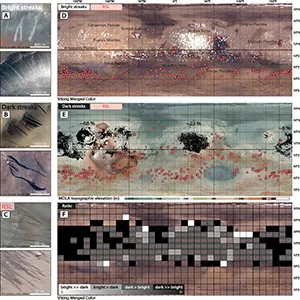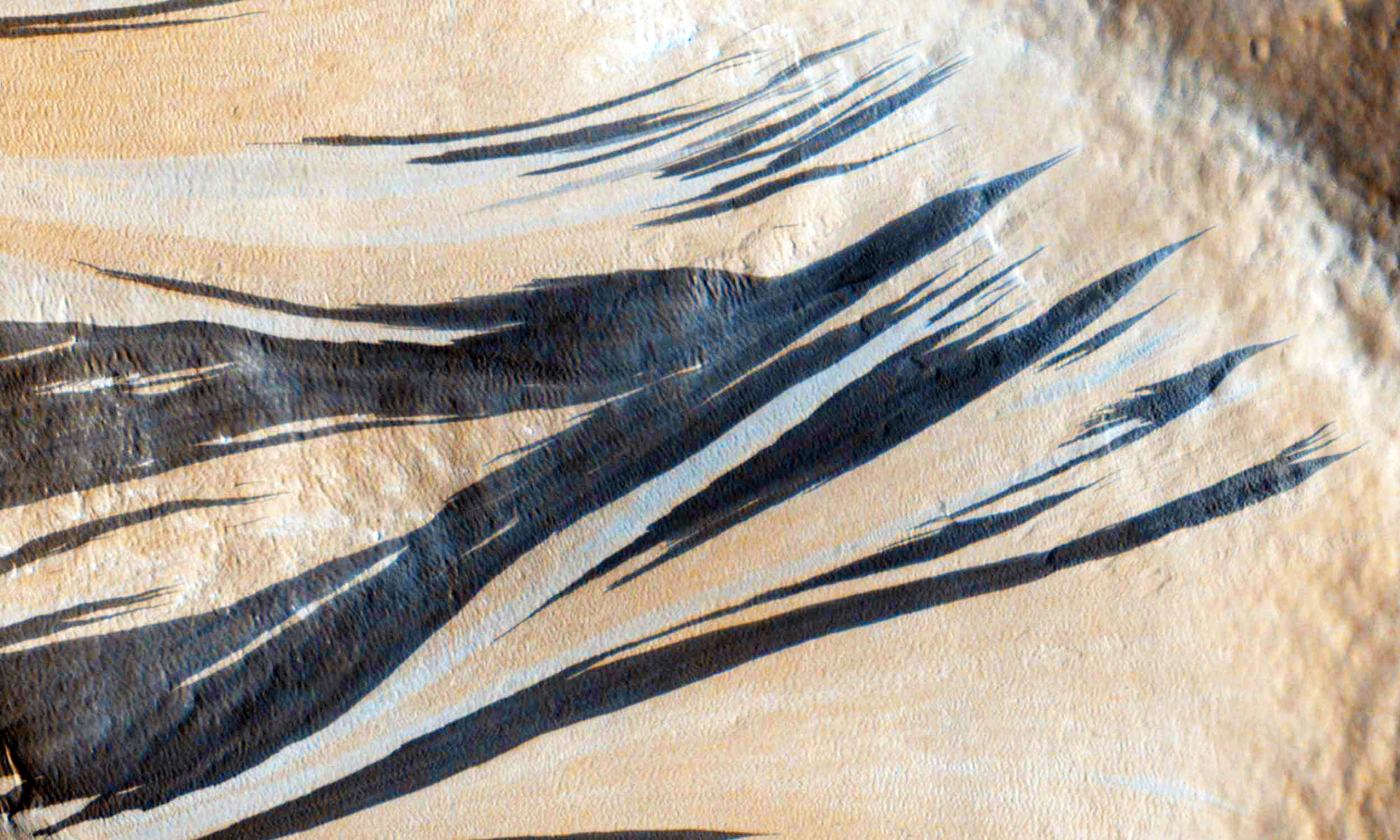Dark, finger‑like marks slide down countless Martian cliffs each year. These stripes have prompted decades of speculation about water still trickling across the Red Planet.
A new analysis of 500,000 of these features shows that they form through avalanches of dry dust, report Valentin Tertius Bickel of the University of Bern and Adomas Valantinas of Brown University.
Why the Martian stripes matter
For almost 50 years, scientists have puzzled over the dusky streaks that run hundreds to thousands of feet down Martian slopes before slowly fading.
Their shorter‑lived cousins, recurring slope lineae (RSL), appear seasonally and were once thought to be briny trickles that might shelter microbes.
If liquid water were involved, these sites would demand strict planetary‑protection rules and might even hint at present‑day habitability.
Proving the absence of water, therefore, reshapes exploration priorities and eases contamination worries.
Building a map of dust‑based stripes
Bickel and Valantinas trained a deep‑learning model on images from the Mars Reconnaissance Orbiter and scanned 86,000 photographs, thus assembling the first global catalog of half a million Martian stripes.
The map shows that streaks cover less than 0.1 percent of Mars’ surface, yet shuffle enough dust each Martian year to rival several planet‑wide storms.
Most stripes cluster between 40 degrees north and 20 degrees south, in the dustiest lowlands where reflectance is high and grain size is tiny.
Bright, older streaks outnumber fresh dark ones by roughly 37 to 1, revealing a surface that is still reworked long after volcanic and fluvial eras ended.
Wind, impacts, and avalanches
The study found no link between Martian stripes and humidity, subsurface ice, or temperatures that ever rise above the freezing point.
Instead, stripe density rises sharply in areas with above‑average wind speeds and fresh impact craters, suggesting that blasts and gusts dislodge blankets of ultra‑fine dust.
“Once we had this global map, we could compare it to databases of temperature, wind speed, and rock‑slide activity. Then we could look for correlations over hundreds of thousands of cases,” said Bickel.
High‑resolution images catch some streaks cascading minutes after nearby meteorites land, while others follow seasonal dust deposition peaks tracked by orbital weather models.
Laboratory experiments with micron‑scale grains show that such powders can flow like a liquid under Mars’ weak gravity, giving the stripes smooth outlines.
Future investigations of Martian stripes
Because the streaks are dry, rovers and landers can safely approach them without risking forward contamination of a hidden oasis.
The dusty gullies also provide natural “core samples” of surface coatings, which offer clues to recent climate cycles without the need for drilling.
Planetary‑protection officers may reroute planned missions away from suspected wet spots and toward subsurface ice, where astrobiological potential remains stronger.
For human explorers, the result underscores that liquid water is still locked in ice or vapor, simplifying landing‑site selection but highlighting the need for in‑situ resource extraction.
Dust stripes and climate dynamics
The dust shifted by Martian stripes isn’t just a cosmetic feature, it’s part of a much larger atmospheric loop.
Each Martian year, flowing stripes displace enough dust to rival multiple global dust storms, suggesting that they play a bigger role in regulating Mars’ thin, dusty air than previously thought.

This ongoing redistribution could influence seasonal temperature patterns, surface reflectivity, and even the strength of regional wind systems.
Researchers haven’t yet observed the dust entering the atmosphere during a stripe’s formation, but models suggest this movement contributes significantly to the surface-atmosphere dust exchange budget.
Martian dust stripes flows like a fluid
The motion of Martian slope stripes mimics the behavior of liquids, even though they consist of dry dust.
Laboratory studies on granular materials show that fine particles can flow downhill in dense, smooth waves, especially in low-gravity environments like Mars.
On Earth, this kind of granular flow is seen in slow-moving avalanches or the collapse of powdery hills.
On Mars, it may explain why slope stripes form without leaving behind visible dust clouds. The dust might move in tightly packed sheets, held together by electrostatic forces and grain-to-grain interactions.
The unanswered questions
Researchers still debate why RSL favor sun‑facing southern highlands while most Martian stripes sit in northern lowlands. They question whether this is related to different grain sizes or bedrock textures.
Dust‑devil tracks often skirt stripe fields but rarely overlap, raising puzzles about the effects of localized wind turbulence and static charging.
Future high‑cadence imaging could reveal exactly how fast each stripe forms, whether seconds or hours, and whether Marsquakes ever help kick‑start an avalanche.
For now, the Red Planet’s famous stripes turn out to be the work of wind and impacts, not water, deepening our understanding of a world that remains strikingly dry.
The full study is published in Nature Communications.
Image credit: NASA / JPL-Caltech / University of Arizona.
—–
Like what you read? Subscribe to our newsletter for engaging articles, exclusive content, and the latest updates.
Check us out on EarthSnap, a free app brought to you by Eric Ralls and Earth.com.
—–
